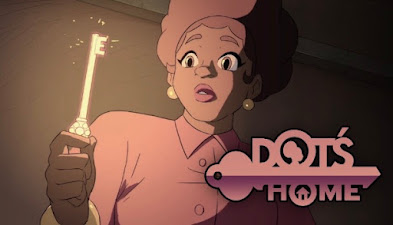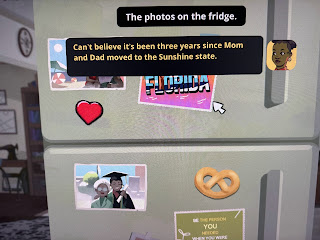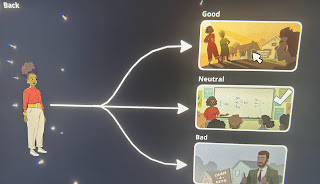Dots Home: A Moral Dilemma
Dot's Home: A Moral Dilemma
There I was, browsing the interwebs for a new game to play. I was looking for something quick and simple. Somehow I stumbled across the title Dot's Home and was immediately intrigued. It's not every day I see the main character in a video game look just like me. I was super excited and downloaded the game.
Dot's Home is a game developed by Weathered Sweater, Aerial_Knight, and Titan ARX Interactive. It was published by the Rise-Home Stories Project and released on October 22, 2021. Recently, I've taken a liking to click-and-point games. I was happy to see there weren't intricate keyboard buttons I had to mash to play this one. Dot's Home is a visual novel and our job as players is to get to know the protagonist's family story and make decisions. If you are a person who enjoys intense gameplay and grinding, this definitely is not for you. Nonetheless, Dot's Home addresses important topics necessary for human growth. Keep on reading to learn more about this adventure.
What Is Dot's Home About?
 |
| Picture from Steam.com |
Dot's Home follows our main protagonist Dorothea Hawkins (who goes by Dot) a black woman in her mid-20s who resides in Detroit, Michigan. Dot lives in a house with her grandmother Mavis and nephew Carlos. The home in which they live has stayed within the family for decades which is why Grandma Mavis never left it, even when everyone else did. Dot's entire family: Mom, Dad, and sister are all removed from the home and live far away but Dot chose to stay with her grandma in Detriot. Players learn very quickly that this will be a visual narrative that is not afraid of tackling prevalent social issues. Dot's Home touches on gentrification, racial inequality, and family legacy. All of this is done within about an hour or so of gameplay. The game is available to play for free on Steam and the Apple Store.
I have a lot of thoughts and perhaps criticisms about the game however, I find the overall story and message important. I did also find myself in a bit of a moral dilemma. I will explain further in this article as I focus on the central themes of the game: family legacy and gentrification.
Family Legacy
Dot's Home has a really exciting plot that I personally enjoy - time travel! The game takes place in a unique, mirror-like dimension, which players spend a significant amount of time traversing through. During this journey, players get to learn about Dot's family, their struggles, triumphs, and their legacy.
 |
| Picture from my Dot's Home gameplay |
As mentioned, Dot lives with her grandmother Mavis, who is the first character we are introduced to (besides Dot). Grandma Mavis is widowed and only has Dot and Carlos in her life at this point in time. We learn that many changes are being pushed into the Detriot neighborhood that Mavis and her grandchildren have lived in for many years. Between a pushy realtor named Michael Murphy III and unfavorable housing conditions, Mavis is concerned about the legacy of the house she and her husband, Carl, worked hard to obtain. We learn that the couple moved from their laborious (and free) work on farms in the South and headed towards the North for better work opportunities and living conditions. This home in Detriot is where they built a name for themselves and raised their son Hank. Once Hank became an adult, he married Evelyn and had two daughters, Georgia and Dot. Based on player decisions, Dot's parents may or may not have lived in the house with Mavis to raise their girls. However, once everyone becomes independent, we learn Dot's parents moved to sunny Florida. As for her sister Georgia, it's not said where she and her wife Ava live but they are also far away.
 |
| Picture from my Dot's Home gameplay |
Since the other surviving family members have left the nest, Mavis gives her granddaughter Dot the task of figuring out if she wants to sell the house to Michael from Hope Equity or keep the house and pass it down to the next generation once she is done taking care of it. As mentioned, the home has a lot of issues. There's an awful leak in front of Dot's bedroom and the basement where her young nephew Carlos likes to play video games aggravates his asthma. These unfavorable house conditions and the rise of the cost of living due to Hope Equity's renovations put each character and even players in a moral dilemma. Should Dot stay in a neighborhood that is implementing mass changes, spiking up the cost of living, and not helping to maintain the value of the old property, or should she move on and build community elsewhere?
For Some, the answer to these questions might be simple. However, I'd like to give a little insight into the neighborhood that I've lived in basically all my life. I am seeing it become gentrified right before my eyes.
My Insight
Being born and raised in the inner city of New York has helped me put a lot of things into perspective when it comes to environmental issues. Of course, as a child, it seemed like a blessing to be born in one of the most popular cities in the world. It's a lot of people's dream to move to New York City and make a name for themselves. This city is very sensationalized with Broad Way, Times Square, and the Empire State Building being huge staples. However, have people outside of New York ever thought about what the inner city looks like? How specific boroughs are impacted by all of these changes? Take Harlem for instance, I am not from there but have visited many times as a New Yorker. Harlem is a historical borough within the city. While an undergrad, I took a course on the Harlem Renaissance and learned a lot of amazing things. The fact that it took me until adulthood to learn more about this is quite appalling as contributions that were made by people of Afro descent have been minimized or even obsolete in childhood education (but that's a topic for another day). Regardless, if one goes to Harlem now, it will look completely different than what it looked like in the early 2000s and the 90s. Gentrification staples, such as Starbucks and Whole Foods stand tall within the area of Harlem I frequent. Don't get me wrong, I love some Starbucks and Whole Foods. Nonetheless, it's such an interesting juxtaposition to see these places in an environment where there are homeless people most with addictions who are standing outside watching you get your Caramel Macchiato and healthy groceries. Here's a small anecdote: I used to work at Whole Foods in my early 20s. One day I became curious and decided to compare the produce that's sold in this Manhattan grocery store to the produce sold in the borough I am from the Bronx. And boy, the difference in quality was alarming. Most of the produce in our Price Choice/ Stop and Shops were bruised badly and rotten, while the produce at the Whole Foods in Manhattan was gorgeously intact. They even offered organic options of fruits and vegetables. Even though there isn't a Whole Foods in the Bronx (to my knowledge) we have plenty of Starbucks. One was just built within the Bay Plaza Mall (even though we already have one in that area). I've also seen houses in my neighborhood since I was a little girl get torn down and replaced with fancy-looking apartment buildings (yet they won't renovate the old rundown building we've been living in for 20+ years). It's all just interesting. Now, I'm not proactive in my community like Dot's dad, Hank. I've learned to be lowkey since that is how my family has always been. This is why I view Dot's situation as a moral dilemma, at least for me. I am very much okay with moving perhaps because I have been in the same place my entire life. Another thing I've grappled with is feeling like I don't belong in my community. A lot of layers to this one for me folks!
Gentrification
The newspaper reads:
Based on this article alone, we learn that there are two sides to how gentrification can impact a community. For Anderson, he appreciates how gentrification brought value to his community. He cited the community was "dead quiet." However, he believes it is thriving now due to gentrification. However, Derocha has valid concerns regarding these changes. She speaks on the poor air quality caused by overproduction within her community. She also touched on the fact that most if not all of her family are asthmatics. I found this line particularly relevant to me. I have 5 close family members who deal with asthma, only one used to smoke, and all were raised in New York City.
Final Thoughts
The game developers of Dot's Home have made a commendable decision by taking a stance on a topic that is important to them. Dot's Home presents choices that are not explicitly labeled as 'good' or 'bad', but they do determine the player's stance on the topics of gentrification and family legacy. Dot's Home offers three different outcomes that players can choose from by meeting Dot's parents and grandparents from the distant past, and then Dot's sister and wife in the close past. The players' choices will lead them to one of the three different endings.
 |
Picture from my Dot's Home gameplay |
During my first gameplay, I received a neutral ending which hinted at a possible "better" ending. However, I was satisfied with the choices I had made throughout the game. I would overall recommend Dot's Home to people who enjoy visual novels and want something quick but impactful to play. I enjoyed playing Dot's Home and embarking on its journey.



Comments
Post a Comment